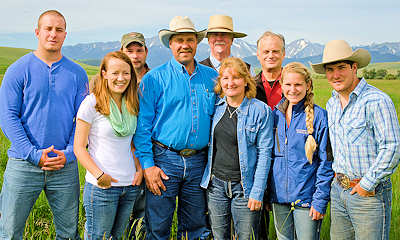July 20, 2015

Recently, at the 2015 Cattle Industry Summer Conference, seven regional ranches were recognized as part of the Environmental Stewardship Award Program. These regional winners compete for the national aware, which will be announced during the 25th anniversary celebration in January 2016.
For Western Farmer-Stockman readers, two of the honorees are in the region. Today we focus on Montana where American Fork Ranch of Two Dot was honored.
The American Fork Ranch was established in 1882 and dates back to the days of the Montana territory. The Stevens family has owned the ranch since 1945 and currently the fifth generation is actively involved in ranch operations and the community.

This crew from American Fork Ranch has worked hard to retool pastures for cattle that have boosted productivity, but also enhanced wildlife populations on the Montana operation. (Photo: NCBA)
Jay Bodner, Montana Stockgrowers Association director of natural resources, says: "Under the management of Jed and Annie Evjene, the American Fork Ranch has experienced a transformation in sustainability, stewardship and conservation through a number of public and private partnerships. Through a dedication to long-term stewardship, the American Fork Ranch continuously works to improve their cattle operation to benefit their environment, wildlife, resources, community and employees."
According to the release profiling the operation, American Fork Ranch has found that what's good for cattle production is also good for the wildlife. By improving pastures through cross fencing and adding an extensive system of waterlines, the work has improved habitat for native animals.
In 2008, the ranch embarked on a extensive program to rejuvenate the ranch's native prairies. To do this, the Evjenes worked in partnership with the Natural Resources Conservation Service and its Environmental Equality Incentives Program. This program helped them to cross-fence, develop water, complete range assessment of the ranch, collect soil samples and develop a formal and intricate rotational grazing program.
The largest implementation was the addition of 25 miles of interior cross fencing. This divided 23 pastures that were once very large into more efficient average sizes of 350 acres, creating 39 efficient grazing pastures.
A grazing plan>>>
~~~PAGE_BREAK_HERE~~~
Grazing each pasture for seven days allowed the ranch to keep forage in front of the livestock and increase weaning weights on calves, while increasing overall herd health. Pasture start times were adjusted so each pasture is not used at the same times each year. Resting each pasture for 45 days between rotation cycles allowed the Evjenes to clearly monitor the growing and sustained health of the range as the native plants and wildlife mature and flourish.
Some of the dominant wildlife species that share the open spaces of the ranch and its riparian corridors include antelope, whitetail deer, mule deer, elk, moose, black bear, mountain lion, bobcat, coyotes, ducks, geese, sandhill cranes, eastern brook trout, along with several other wildlife species.
Adds Jed Evjene, in a media release: “Being able to walk out here or drive here and see good healthy livestock, good healthy wildlife, clear running water and lots of grass. Knowing that we as a team worked together to succeed in this is very rewarding for all of us here on the ranch. We wouldn’t have it any other way.”
ESAP is sponsored by Dow AgroSciences, USDA NRCS, U.S. Fish and Wildlife Service, National Cattlemen’s Beef Association and the National Cattlemen’s Foundation, and is presented to farmers and ranchers who demonstrate a commitment to protecting the farm and ranch land in their care.
Tomorrow we'll share the profile of a Nevada operation that is also one of the seven honorees.
You May Also Like




